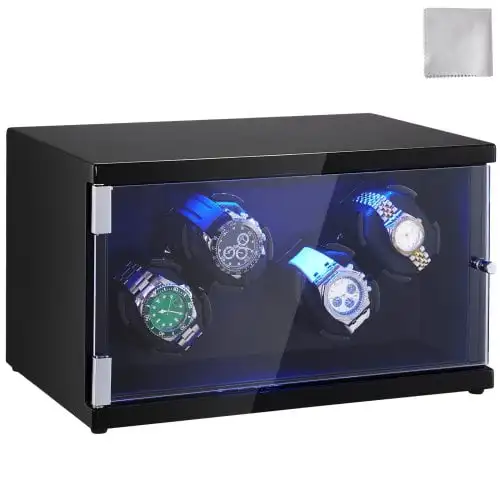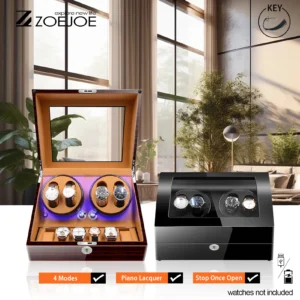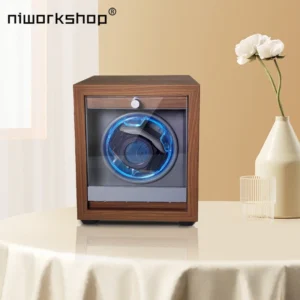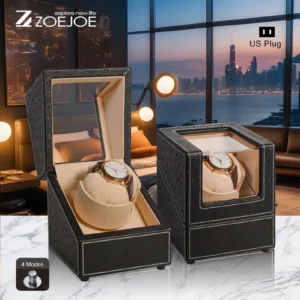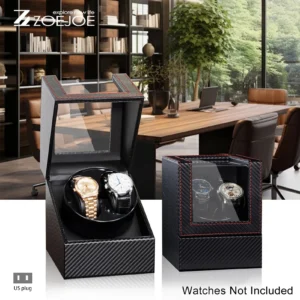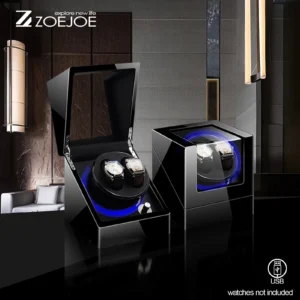Introduction to Watch Winder Motors
Watch winders are specialized devices designed to keep automatic watches running when not being worn. These ingenious machines mimic the natural motion of your wrist, keeping the mainspring of an automatic watch wound and ready for use. While many elements contribute to a quality watch winder, the motor is undoubtedly the heart of the entire system.
The motor in a watch winder directly impacts several crucial aspects of performance:
- Noise level – determining whether your winder will be a silent companion or a distracting presence
- Durability – affecting how many years of reliable service you’ll receive
- Precision – influencing how accurately your watches are maintained
- Energy efficiency – impacting power consumption and operating costs
Selecting the right motor type is essential, especially when considering that automatic watches typically require between 650-1,800 rotations per day to stay properly wound. Poor-quality motors can lead to irregular winding patterns, excessive noise, premature failure, and in worst cases, damage to your precious timepieces.
In this comprehensive guide, we’ll explore the various types of motors used in watch winders, their unique characteristics, and how to select the ideal option for your specific needs. Understanding watch winder motor specs will help you make an informed decision when investing in a quality winder for your collection.
Our collection of premium watch winders features carefully selected motors to ensure optimal performance and watch care.
Primary Types of Watch Winder Motors
A. Japanese Motors (Mabuchi Motors)
Mabuchi motors represent the industry standard in mid-range and quality watch winders, offering an excellent balance between performance and cost. These Japanese-engineered motors have earned their reputation as the “gold standard” for reliability-to-cost ratio in the watch winder market.
Key characteristics of Mabuchi motors include:
- Noise level: Typically operating at 10-20 decibels, roughly equivalent to a whisper or rustling leaves
- Durability: Average lifespan of 5-7 years with continuous operation
- Precision: Reliable TPD (Turns Per Day) settings with minimal deviation
- Value: Excellent performance-to-price ratio compared to other motor options
Many reputable mid-range winder manufacturers specifically highlight the use of genuine Mabuchi motors in their products, as these motors have proven their reliability over decades of use. They provide consistent torque and smooth operation while maintaining reasonable noise levels that won’t disturb most users, even in bedroom environments.
For collectors with multiple watches of varying values, winders equipped with Mabuchi motors offer dependable performance without the premium price tag of higher-end options.
The efficiency and reliability of these motors make them ideal for daily use, and understanding watch winder motor power specifications helps collectors appreciate why Mabuchi has remained the preferred choice for many manufacturers.
B. German Engineered Motors
German engineered motors represent a significant step up in the watch winder motor hierarchy, embodying the precision engineering philosophy that German manufacturing is renowned for worldwide.
These motors feature:
- Ultra-quiet operation: Typically operating under 10 decibels, often imperceptible in most environments
- Superior component quality: Precision bearings, higher-grade metals, and tighter manufacturing tolerances
- Extended longevity: Expected lifespan of 8-10+ years of continuous operation
- Enhanced precision: More consistent rotation speeds with minimal variation
While German motors command a premium price, the investment delivers noticeable benefits. The near-silent operation makes these winders ideal for bedside placement, while the superior durability means years of trouble-free operation.
For collectors with valuable timepieces, the precision of German motors ensures watches receive exactly the movement they require—not too much, not too little. The engineering focus on reducing vibration also means watches are subjected to smoother motion, mimicking natural wrist movement more accurately.
C. Swiss Precision Motors
Swiss precision motors represent the pinnacle of watch winder motor technology, reflecting the same meticulous standards that have made Swiss watchmaking legendary.
Notable characteristics include:
- Near-silent operation: Often below 5 decibels, virtually inaudible in any environment
- Exceptional precision: Maintains exact TPD specifications with minimal variation
- Compact design: Engineered for space efficiency without sacrificing performance
- Superior materials: Highest grade components throughout the motor assembly
Swiss motors are most commonly found in luxury watch winders designed for collectors with significant investments in fine timepieces. While they represent the highest price tier, they deliver unmatched performance in noise control, precision, and longevity.
The heritage of Swiss engineering in the watch industry means these motors are designed with an intimate understanding of what automatic watches require. Many high-end motor technology in high-end watch winders draws from the same precision engineering principles that govern the watches themselves.
D. Direct-Drive Motors (Brushless Technology)
Direct-drive brushless motors represent the cutting edge of watch winder technology, offering significant advantages over traditional brushed motor designs.
Unlike conventional motors that rely on carbon brushes for electrical contact (which eventually wear out), brushless direct-drive technology eliminates this friction point entirely. This modern approach provides several key benefits:
- Reduced mechanical noise: Fewer moving components means less operational sound
- Improved reliability: No brush wear means fewer failure points
- Enhanced energy efficiency: Less energy lost to friction, reducing power consumption
- Smoother operation: More precise control of rotation speed and movement
These motors are increasingly appearing in premium watch winders as manufacturers embrace their superior performance characteristics. The initial higher cost is offset by longer service life and reduced maintenance requirements.
For collectors concerned about energy efficiency, direct-drive motors typically consume 20-40% less power than traditional motors while delivering comparable or superior performance.
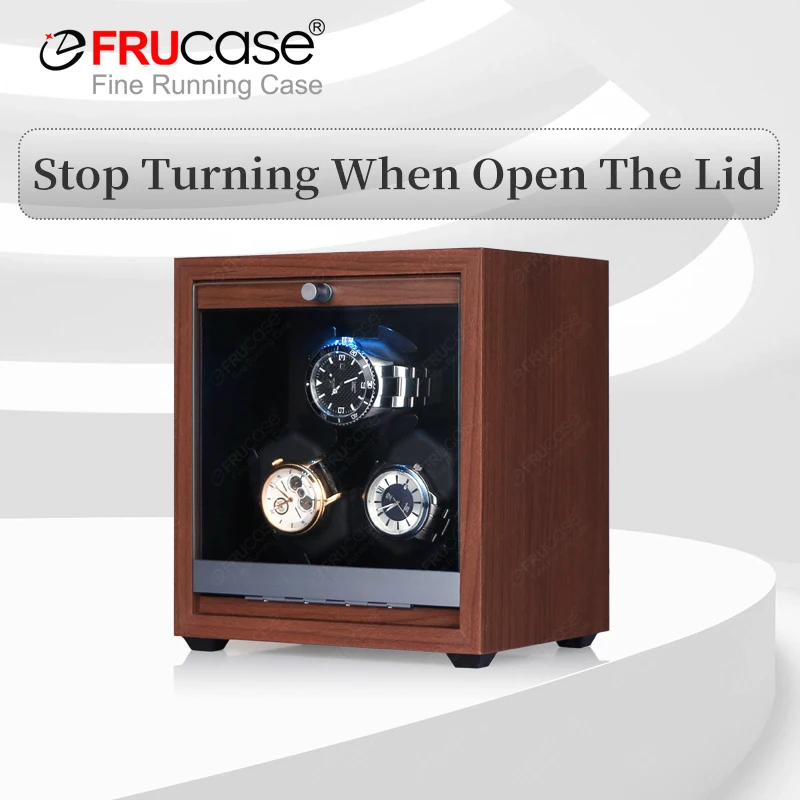
E. Stepper Motors
Stepper motors offer a unique approach to watch winder mechanics, providing exceptional precision through incremental rotational movements rather than continuous motion.
These specialized motors work by dividing a full rotation into hundreds of precise steps, allowing for:
- Extremely accurate positional control: Precise stopping points during rotation cycles
- Programmable movement patterns: Ideal for custom winding profiles
- Variable speed control: Easily adjusted for different watch requirements
- Controlled acceleration/deceleration: Smoother starts and stops
Popular in programmable and DIY watch winder projects, stepper motors like the common 28BYJ-48 model provide makers and enthusiasts with granular control over every aspect of the winding process. This makes them particularly valuable for collectors with watches that have unique or specific winding requirements.
While not as common in commercial watch winders, stepper motors excel in applications where precise control over rotation angles and pauses is required. Their ability to execute complex rotation patterns makes them ideal for collectors who prefer customizable winding profiles for their specific timepieces.
Our automatic watch winders utilize precision motors selected for optimal performance with a wide range of watch movements.
F. Budget/Generic Motors
Budget or generic motors represent the entry-level option in watch winders, typically found in lower-priced units aimed at casual users or those new to automatic watches.
These motors vary significantly in quality and performance, with common characteristics including:
- Higher noise levels: Often starting at 25-30 decibels and increasing over time
- Limited lifespan: Typically 1-3 years before notable performance decline
- Inconsistent precision: Greater variation in TPD delivery
- Simpler construction: Fewer noise-dampening features or precision components
While budget motors make watch winders accessible at lower price points (often under $100), they come with notable trade-offs. Noise levels frequently increase within months of use as components wear, and precision may drift over time, potentially leading to under or over-winding of watches.
For occasional use with moderately priced watches, these motors may be adequate. However, for valuable timepieces or daily use, the initial savings are usually overshadowed by shorter lifespan and potential performance issues.
When evaluating budget winders, look for those that at least specify the motor type rather than omitting this crucial information, which often indicates the lowest quality components.
Key Performance Attributes of Watch Winder Motors
A. Noise Level Considerations
The noise level of a watch winder motor is often the first quality indicator users notice, especially when placing winders in bedrooms, offices, or display areas where quiet operation is essential.
When evaluating noise levels, consider:
- Placement environment: Bedroom settings benefit most from ultra-quiet motors (under 10dB)
- Background noise: A winder that seems quiet in a noisy showroom may be noticeably loud in a quiet bedroom
- Progressive noise: Quality motors maintain their noise profile over time, while budget options often become louder with use
To put watch winder noise levels in perspective, consider these comparisons:
– 0-10dB: Breathing, rustling leaves (Swiss/German premium motors)
– 10-20dB: Whisper, ticking watch (Quality Japanese motors)
– 20-30dB: Quiet library, soft whisper (Entry-level motors when new)
– 30-40dB: Quiet bedroom at night (Budget motors after extended use)
Superior watch winders incorporate additional noise-dampening features beyond the motor itself, including rubber mounts, acoustic insulation, and properly balanced rotation mechanisms. Our collection of quiet watch winders addresses this crucial aspect of winder performance.
B. Durability and Longevity Factors
The durability of watch winder motors varies dramatically between different types and quality levels, directly affecting the long-term value of your investment.
Key components influencing motor longevity include:
- Bearings: Higher-quality sealed bearings resist dust and maintain smooth operation
- Brushes (in traditional motors): Carbon brush quality and design impact wear rates
- Gearing: Precision-cut metal gears outlast plastic components substantially
- Heat management: Better motors include design elements to dissipate heat effectively
When considering the value proposition of different motor types, it’s helpful to calculate cost-over-time rather than just initial investment. For example, a $300 winder with a German motor lasting 8+ years ($37.50/year) may provide better value than a $100 winder with a budget motor lasting only 2 years ($50/year).
Proper maintenance can extend motor life substantially. This includes:
– Keeping winders dust-free
– Allowing proper ventilation
– Following recommended duty cycles
– Addressing unusual noises promptly
For collectors serious about maintaining their timepieces, the watch winder motor durability guide provides essential information for maximizing motor lifespan and performance.
C. Precision Control Capabilities
Motor precision directly impacts how effectively a watch winder maintains your automatic watches. Different watches require specific TPD (Turns Per Day) ranges and directional settings to maintain optimal power reserve without causing excess wear.
Critical precision factors include:
- TPD accuracy: How closely the actual rotation count matches the selected setting
- Directional control: Ability to rotate clockwise, counterclockwise, or bidirectionally
- Consistency: Maintaining the same rotation pattern over extended periods
- Rest period timing: Precision in alternating between active and rest periods
Watch models vary significantly in their winding requirements. For example:
| Watch Movement Type | Typical TPD Range | Directional Preference |
|---|---|---|
| Rolex calibers | 650-800 TPD | Bidirectional |
| Omega Co-Axial | 800-900 TPD | Bidirectional |
| Patek Philippe | 800-1000 TPD | Bidirectional |
| Seiko Automatic | 500-800 TPD | Bidirectional |
| JLC calibers | 600-800 TPD | Often bidirectional |
Quality motors provide precise control over these parameters, ensuring watches receive exactly the motion they need. Budget motors often lack this precision, potentially leading to underwinding (causing watches to stop) or overwinding (creating excessive mainspring tension).
For collectors with diverse collections, understanding TPD in watch winders is essential for proper care of different watch movements.
D. Power Efficiency and Source Options
Watch winder motors offer various power options, each with distinct advantages depending on your usage patterns and placement needs.
Common power configurations include:
- AC power: Consistent performance for stationary use, no battery replacement needed
- Battery power: Placement flexibility, ideal for locations without accessible outlets
- USB power: Modern convenience with potential for power bank compatibility
Power efficiency varies significantly between motor types. Premium motors typically consume 30-60% less power than budget options while providing superior performance. This difference becomes particularly important for:
- Battery-powered units where efficiency extends operation time
- Continuous operation where energy costs accumulate over years
- Environmental considerations regarding power consumption
Typical battery life varies by motor quality:
– Premium motors: 3-6 months on standard batteries
– Mid-range motors: 2-3 months on standard batteries
– Budget motors: Often less than 1 month on standard batteries
For environmentally conscious collectors or those concerned about operating costs, understanding how much electricity watch winders use helps make informed decisions about winder selection and operation.
E. Anti-Magnetization Features
A critical but often overlooked aspect of watch winder motor quality is magnetic field management. Electric motors inherently generate magnetic fields that can potentially affect the delicate balance mechanisms in mechanical watches.
Quality watch winders incorporate specific design elements to address this concern:
- Magnetic shielding around the motor compartment
- Strategic motor placement at maximum distance from watch holders
- Low magnetic signature motors specifically selected for watch winder applications
- Mu-metal or similar magnetic insulation materials in premium units
Watches particularly susceptible to magnetization include:
– Older watches without modern anti-magnetic components
– Watches with non-silicon hairsprings
– Models without soft-iron inner cases
Signs that a watch may have been affected by magnetism include sudden timing irregularities or significant rate changes. Quality watch winder manufacturers address these concerns through thoughtful design and component selection, particularly in their premium offerings.
Choosing the Right Motor for Your Needs
A. Key Factors to Consider
Selecting the ideal watch winder motor requires balancing several key considerations to match your specific needs:
- Budget constraints: Determine your initial investment comfort level while considering long-term value
- Noise sensitivity: Consider placement environment (bedroom, display cabinet, office)
- Collection value: Higher-value watches justify investment in premium winding solutions
- Collection size: Current and anticipated future collection growth
- Usage pattern: Daily rotation versus occasional use affects motor durability requirements
When evaluating watch winders, consider these decision factors:
- For valuable collections ($5,000+ per watch): Premium Swiss or German motors offer appropriate protection
- For mixed collections: Quality Japanese motors provide excellent balance of performance and value
- For bedroom placement: Prioritize ultra-quiet operation (Swiss/German) or quality Japanese motors
- For visible display areas: Consider not just motor quality but the overall aesthetic design
- For long-term value: Calculate cost-per-year based on expected lifespan rather than initial price
The investment in a quality motor often represents a small percentage of the value of the watches being maintained, making it a reasonable insurance policy for protecting valuable timepieces.
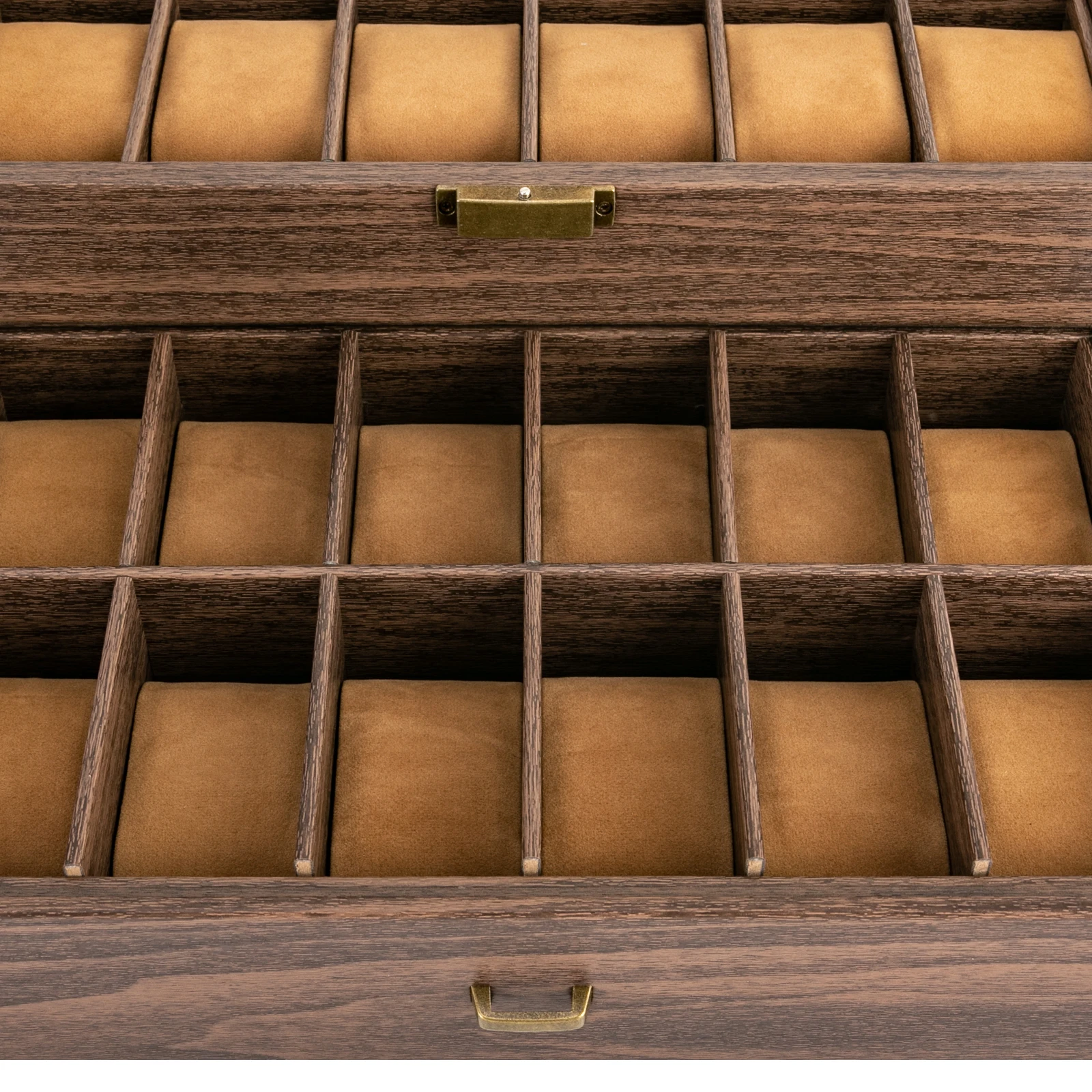
Our luxury watch winders feature premium motors selected specifically for discerning collectors.
Automatic Watch Winder, Luxury Watch Winder, Single Watch Box
$307.39 Select options This product has multiple variants. The options may be chosen on the product page4 Watch Winder, 6 Watch Box, Automatic Watch Winder
$512.31 Select options This product has multiple variants. The options may be chosen on the product pageAutomatic Watch Winder, Single Watch Winder, Wooden Watch Holder
$201.76 Select options This product has multiple variants. The options may be chosen on the product pageAutomatic Watch Winder, Leather Watch Travel Case, Single Watch Winder
$146.30 Select options This product has multiple variants. The options may be chosen on the product pageAutomatic Watch Winder, Double Watch Winder, Leather Watch Boxes
$147.60 Select options This product has multiple variants. The options may be chosen on the product pageAutomatic Watch Winder, Double Watch Winder
$206.18 Select options This product has multiple variants. The options may be chosen on the product page
B. Recommendations by Watch Collection Type
Different collection types benefit from specific motor technologies. Here’s a guide to help match your collection with the optimal motor type:
| Collection Type | Recommended Motor | Key Benefits | Investment Range |
|---|---|---|---|
| High-value luxury watches | Swiss/German motors | Near-silent operation, superior precision, longest lifespan | $300-1,000+ |
| Mixed collection with some luxury pieces | Japanese Mabuchi motors | Reliable performance, good value, moderate noise levels | $150-400 |
| Single daily-wear automatic | Quality Japanese motor | Dependable operation, reasonable cost, adequate precision | $100-250 |
| Budget-conscious collectors | Better-grade generic motors | Basic functionality while minimizing initial investment | $50-150 |
| Silent operation priority | German/Swiss motors | Ultra-quiet performance for sensitive environments | $300-800 |
For specialized collections with unique requirements, consider programmable winders with stepper motors that allow customization of rotation patterns and rest periods.
Potential Issues and How Quality Motors Prevent Them
Watch winder motors can develop several issues that impact both the winder’s performance and potentially the watches themselves. Quality motors incorporate specific features to prevent these problems:
Progressive noise deterioration
– Budget motor issue: Bearing wear and brush degradation create increasing noise
– Quality solution: Precision bearings, quality brushes or brushless designs, and proper lubrication maintain quiet operation for years
Rotation inconsistency
– Budget motor issue: Variations in power delivery cause inconsistent TPD delivery
– Quality solution: Regulated power systems and precision gearing maintain consistent rotation regardless of battery level or power fluctuations
Motor failure
– Budget motor issue: Complete failure requiring replacement or unit disposal
– Quality solution: Conservative power ratings, thermal protection, and quality components provide years of reliable service
Vibration transfer
– Budget motor issue: Excessive vibration disturbs watches and creates noise
– Quality solution: Balance optimization, vibration dampening mounts, and precision manufacturing minimize harmful vibration
Magnetization risk
– Budget motor issue: Inadequate shielding exposing watches to magnetic fields
– Quality solution: Proper shielding, strategic motor placement, and low-magnetic signature components protect sensitive watch mechanisms
For existing winder owners, troubleshooting common watch winder problems can help address issues that may develop over time.
Reputable Watch Winder Brands Known for Quality Motors
The market offers several tiers of watch winder manufacturers, distinguished largely by the quality of motors they incorporate:
Premium tier brands typically feature:
– Swiss or German engineered motors
– Comprehensive 3-5 year warranties covering motor performance
– Detailed specifications regarding motor type and performance
– Handcrafted wooden or luxury material cases with superior insulation
Mid-range quality leaders often include:
– Japanese Mabuchi motors
– Extended warranties of 1-3 years
– Specific noise level ratings
– Quality materials and thoughtful designs at more accessible price points
Value-focused quality brands prioritize:
– Better-grade motors despite competitive pricing
– Clear motor specifications rather than vague descriptions
– Basic but functional designs that protect watches adequately
When reviewing product listings, look for specific motor details rather than vague claims. Quality manufacturers proudly specify their motor sources, noise levels, and performance characteristics rather than hiding behind generic terms like “ultra-quiet” without supporting data.
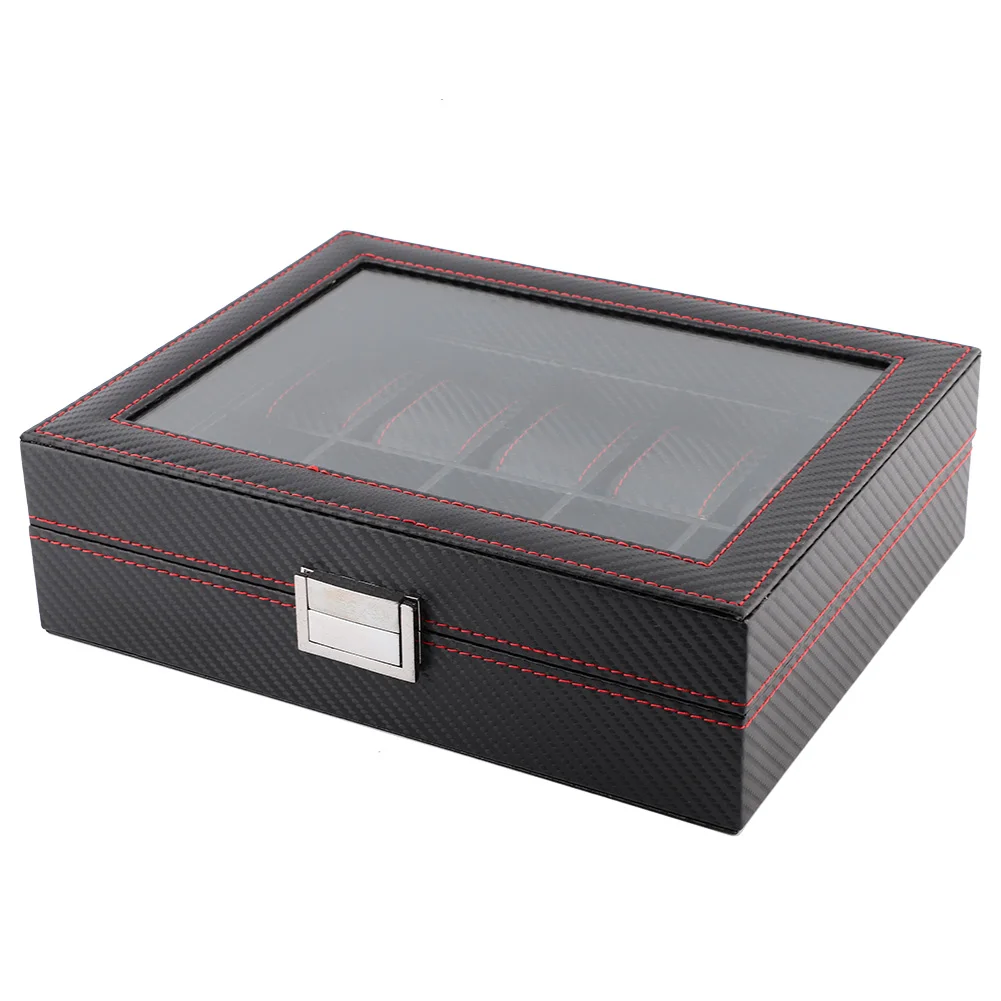
Our single watch winders feature carefully selected motors that balance performance, durability, and value.
Conclusion: Making an Informed Motor Choice
The motor truly functions as the heart of any watch winder, determining not just how well it works today, but how reliably it will perform for years to come. Through this guide, we’ve explored how different motor types—from premium Swiss and German engineering to reliable Japanese Mabuchi motors and modern brushless technology—each offer unique benefits for different collector needs.
When selecting a watch winder, remember that the motor quality should ideally match the value and importance of the watches being maintained. For precious timepieces that represent significant investments, choosing a winder with a premium motor provides appropriate protection and care.
For most collectors, quality Japanese motors offer an excellent balance of performance and value, while those with luxury collections or specific needs may benefit from the premium performance of Swiss or German engineering. Those with noise concerns should prioritize higher-end motors that maintain whisper-quiet operation throughout their extended lifespan.
By understanding the critical differences between motor types, you can make a more informed decision that will provide years of reliable service for your treasured timepieces. Our double watch winders incorporate quality motors selected to provide optimal care for your valuable automatic watches.

